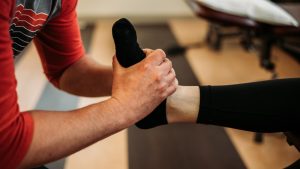Do you often find yourself slouching? Do your shoulders always feel tense and tight? If so, you may need to start doing some physical therapy exercises for posture. Poor posture can lead to all sorts of problems, including back pain, neck pain, and tension headaches. In this blog post, we will discuss the best exercises for improving your posture. We will also provide a few tips on how to stay motivated and stick with your routine!

What is posture and why is it important?
Keeping the right posture is essential for a healthy lifestyle. Posture affects your breathing, body alignment and distribution of weight onto various parts in order to prevent pain or injury from occurring throughout our bodies when we sit up straight with good technique!
Maintaining good postural habits will help you breathe more easily by expanding your lungs fully while standing/sitting upright against an object like furniture; this also aids digestive processes via improved blood flow all around internal organs
Additionally, good posture gives you a sense of confidence and can help you to project a more positive image.
Poor posture, on the other hand, can lead to muscle fatigue, strain injuries, and headaches. It can also make you appear slouchy and unconfident. As you can see, posture is important for both your physical and mental wellbeing.
The benefits of good posture
Good posture is often associated with better physical health, but it can also lead to improved mental well-being. When you sit or stand up straight, your body is better able to take in oxygen and your lungs can expand more fully. This increased oxygen intake can help to improve concentration and increase energy levels.
Good posture can also help to prevent pain in the back, neck, and shoulders. Poor posture can lead to muscle fatigue and strain, as well as headaches and migraines. In addition, good posture can make you appear more confident and project a sense of authority. Whether you’re giving a presentation or interviewing for a job, having a good posture can give you a boost of confidence that can help you to succeed and physical therapy can help with that.
How to correct your posture
Good posture is important for both your health and your appearance. Slouching can lead to back pain, fatigue, and headaches while standing up straight can make you look more confident and alert.
Fortunately, correcting your posture is relatively simple.
First, be aware of how you are sitting or standing. Are your shoulders hunched forward? Is your back rounded? Are your knees locked? Second, make a conscious effort to adjust your position. Take a deep breath and straighten your spine. Let your shoulders relax down and back. Unclench your fists and release the tension in your jaw. third, practice maintaining good posture throughout the day.
Every time you catch yourself slouching, straighten up. Over time, good posture will become second nature. By following these simple steps, you can improve your posture and enjoy all the benefits that come with it.
Good posture is important for both your physical and mental health. Not only does it help to prevent aches and pains, but it also improves your breathing and circulation, and can even make you feel more confident. Unfortunately, many of us have developed bad habits that lead to poor posture. However, there are a few simple exercises that can help to correct your posture and improve your overall health.
To start, stand up straight with your feet hip-width apart. Then, tuck your chin down so that your head is in line with your spine. Next, engage your abdominal muscles and lift your chest up towards the ceiling. Finally, roll your shoulders back and down, and relax your hands at your sides. Once you have straightened your spine, be sure to hold this position for at least 30 seconds. You should perform this exercise several times per day to help improve your posture.
Physical therapy exercises for posture
Developing good posture is an important part of maintaining your health. It can help you avoid back pain and muscle strain, but it’s often caused by tight muscles or weak ones that need to be stretched out before they become painful! Physiotherapy exercises like wall slides are great for improving chest length as well as straightening up our postures because we’re holding ourselves against something else instead of just relying on hands-and feet placement while standing still. To do this exercise properly, stand tall and with your back flat and against a wall.
Once complete making sure your feet are shoulder-width apart. SLOWLY slide down until your knees open up to a 90-degree angle and then try to hold for up to 10 seconds before returning back to your starting position.
For an added challenge, you can try the side-lying windmill. This exercise helps to stretch the muscles along the sides of the body and improve posture by strengthening the muscles in the shoulders and upper back. Similar to above, if you’re in any discomfort that makes this exercise hurt please stop immediately.
Place one hand on a wall for support and position yourself so that both feet are shoulder-width apart. Keeping your back against it, slowly slide down until you’re in a seated goblet pose with bent knees at 90 degrees angle (a la yogi). Hold this position for up to 10 seconds then return back upright without losing balance!
Regularly doing these exercises can help you improve your posture and prevent pain associated with poor posture.
Tips for staying motivated and sticking with your routine
Maintaining good posture is important for overall health, but it can be difficult to stick with a posture improvement routine. Here are a few tips to help you stay motivated:
1. Set realistic goals. Trying to improve your posture overnight is not realistic, and setting lofty goals can set you up for disappointment. Instead, focus on small, achievable goals that you can realistically achieve.
2. Track your progress. Keep track of your progress by taking photos or videos of yourself at regular intervals. This will help you to see the changes in your posture over time and stay motivated to keep up with your routine.
3. Find a support group. Connecting with others who are working on improving their posture can provide motivation and accountability. There are many online groups that you can join, or you could start your own group with friends or family members.
4. Reward yourself. Choose specific milestones to celebrate as you work on improving your posture. For example, you could treat yourself to a new piece of workout gear once you reach a certain goal or level of progress. Celebrating your achievements will help you stay motivated to continue working towards better posture.
Maintaining good posture is not only important for looking and feeling better, it’s also critical for your overall health. Fortunately, there are a number of exercises that can help improve your posture. By incorporating these exercises into your daily routine, you can make a big impact on your health and quality of life.
Do you have any tips for improving posture? Share them in the comments below!
If you’re looking for more guidance on improving your posture, we offer a number of services that can help. Or Find Us Online and we’ll be happy to help!



